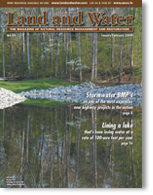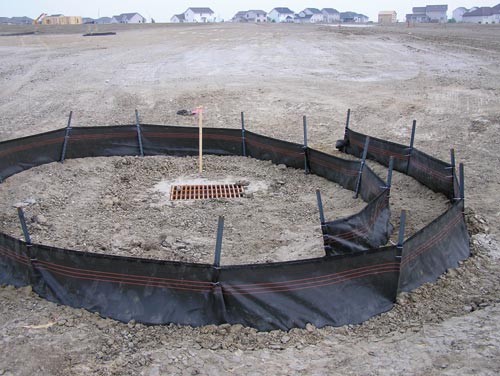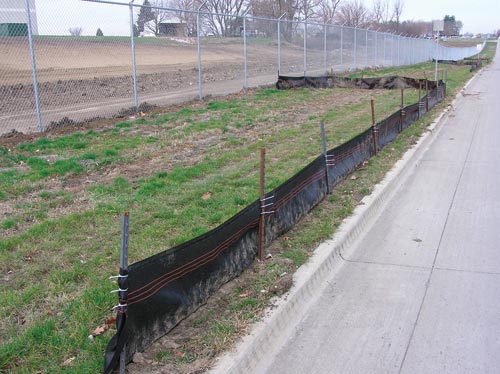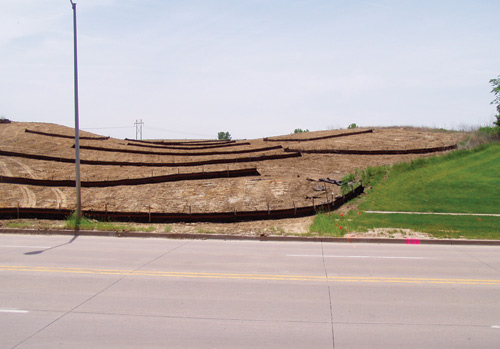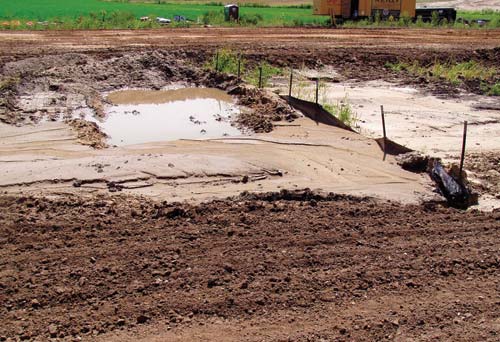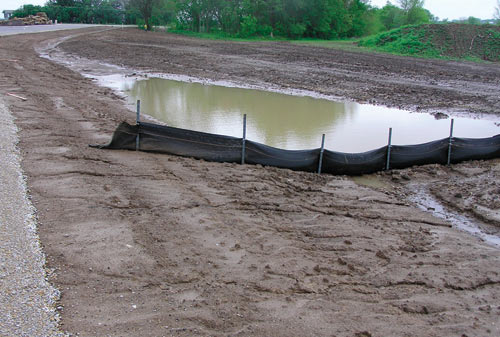Proper Silt Fence Installationby Tom Carpenter |
|
A proper silt fence installation is much more complex than people think – and more than manuals specify. In the past and in many areas today, silt fence is spoken about in one or two sentences and a couple of bullet points. Since it is rarely installed properly, people don’t give it due credit nor understand its potential. Properly installed silt fence is the most effective temporary sediment control device available. It can withstand concentrated flows (not to be confused with continuous flows), heavy winds, and potentially retain 18 inches of sediment – often times 10-20 tons of sediment per run of fence. It is relatively fast to install so it can go in on short notice, inexpensive, and the posts are recyclable. However, it is somewhat better utilized for open construction and residential development sites than individual home lots under construction. For maximum effectiveness, any sediment retention device must filter sediment contained in runoff or pond water for deposition/sedimentation to occur, and that is harder to achieve on an individual lot with busy construction traffic.
And that is one of the two most common problems of silt fence: 1) improper placement where ponding cannot occur, and 2) installation issues such as lack of proper backfill and proper compaction. A proper silt fence installation is like a log chain, if one link is broken, the whole system is ineffective. Silt fence installation has 6 links to be effective: placement, quantity, installation, compaction, posting, and attachment. You can not talk about effective silt fence without including all of the elements. Placement refers to where and in what shape silt fence is placed on site. Remember, silt fence must pond and filter water! No matter how well it is installed, if water runs around the end(s), the silt fence is worthless. It must be placed where it will store water, with the ends higher than the some interior point - often times a ‘smile’ or J-hook shape is required to create a storage area. Long runs should be avoided, and broken up into smaller segments. On-site adjustment to the Storm Water Pollution Prevention Plan (SWPPP) is mandatory for an effective silt fence as slopes, etc. can’t be anticipated on a desktop and designs may have to change to fit the site. A good contractor should have someone on the crew knowledgeable about sediment control to decide the proper placement of silt fence. The first goal is creating a storage area for runoff and filtration, the second is storing the greatest quantity of water without large overflows. Sometimes it is better to say ‘this is not a proper place for silt fence, XYZ is a better option’. Or, ‘silt fence won’t be effective here, we need to move it somewhere else’. Placing silt fence on contours sounds good on paper, but it is very difficult in the field. Installing multiple smiles where you can plan for runoff accumulation and filtration is a better plan. Quantity refers to area of control. A good rule of thumb is a maximum of 100 linear ft. per 10,000 sq. ft. of area. A one inch per hour rain event produces 6200 gallons of water on just 10,000 sq. ft., so for effective design, utilize multiple runs (smiles) to create multiple storage areas, which also reduce the flow velocities. Avoid long runs of silt fence. They usually concentrate the runoff in one area and overflow the fence. Restrict length of runs to less than 200 linear feet.
Installation primarily refers to how it is installed in the ground. There are two generally accepted methods – traditional trenching, and static slicing. Environmental Protection Agency (EPA) co-sponsored research concluded slicing was a very consistent, dependable installation. Trenching was found to have vague specifications and generally performed poorly, but improved when the trench was over-backfilled and compacted prior to posting.1 These elements have now been included in the revised ASTM standard. I believe if a silt fence can not be mechanically installed (sliced in), then it is not a proper placement area for silt fence. Generally, either the space is too small or too steep for ponding to occur, and thus not the right BMP. Mechanical installation does not excavate soil and leave the spoil dispersed, provides consistent and dependable silt fence installation, and reduces many labor-related installation problems. Compaction refers to increasing the soil density. The research concluded there is a high correlation between silt fence efficacy and compaction. Installations with adequate compaction resisted washouts, and those with minimal compaction had poor performance. Compaction minimizes water saturating the soil, and thus stabilizes the installation. Posting refers to proper post spacing and depth in the soil. Posts should be 4-5 ft. apart where water will concentrate, and 6-7 ft. in low stress areas or per the specifications. Posts should be as deep in the ground as the fabric is above the ground. Steel posts are easier to install to the proper depth and have a better life span than wood posts.
Attachment refers to properly securing the fabric to the post because it must support 18 inches of water and sediment. Three plastic ties or wire, installed diagonally within the top eight inches of a steel post perform well. Multiple staples or even a small lathe over the fabric is used to secure fabric to wood posts. The most common problems with silt fence are:
Water, especially in volume, is a tremendous force. Because silt fence is mechanically installed in the soil, and supported mechanically, it can detain hundreds of pounds of sediment and water – even a concentrated flow (contrary to general opinion). Which may bring up the question about wire-backed silt fence? There is a mountain of evidence that properly posted silt fence will retain 18 inches of sediment – without wire. My own experience indicates wire may actually inhibit performance if it is in the trench because it interferes with sealing off the trench. Additionally, wire creates voluminous, expensive disposal costs thus causing greater environmental harm than benefit. The only reasonable excuse for wire (other than it is status quo) has been that construction people don’t like to drive over it, so it doesn’t seem to have much credibility from the bureaucratic side either.
Maintenance of silt fence is a big issue currently. I believe maintenance is fixing it if it is falling down, or repairing/replacing it if it is washed out under the fence. But maintenance is not replacement when it full of sediment. In that scenario, the owner has achieved their benefit, and needs to install new silt fence. As to removing sediment from a silt fence as a maintenance option, I do not support that concept. First of all, how do you remove wet sediment, how do you handle it, and where are you going to take it? And second, the fabric of the silt fence is now completely clogged and can not allow any water to seep through it, so it is no longer functioning as a silt fence, but as a sediment basin with limited capacity.
Removing sediment just does not make sense. It is much better to build a new run of silt fence above or below the existing one, and start fresh. If there is not room, the whole installation must be removed, graded out, and reinstalled. Last, but not least, sediment is real and has physical qualities. A functioning sediment retention device should be retaining runoff and/or sediment after a rain event. Devices are not filtering if there is no evidence of sediment unless, of course, effective erosion control practices have been implemented upstream. The lack of sediment or ponding runoff is a sign of either poor effectiveness or good erosion control and the device should be inspected for washout and failure. For more information, contact Thomas Carpenter, CPESC, e-mail: tom@tommy-sfm.com. 1. EvTEC – Environmental Technology Verification Center – “Installation of Silt Fence using the Tommy Static Slicing Method” |
©2006 - 1998 Land and Water, Inc.

